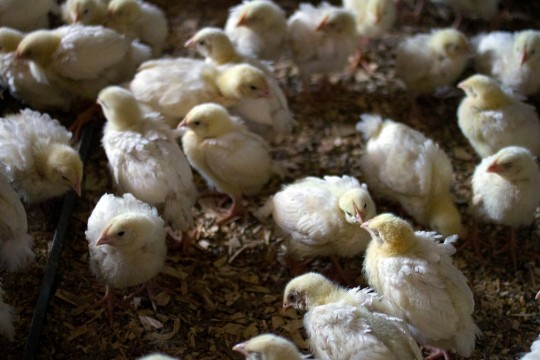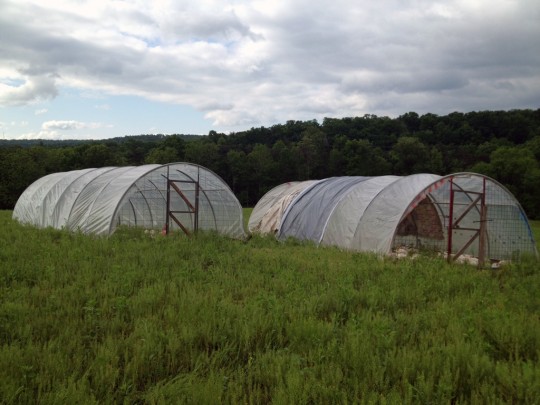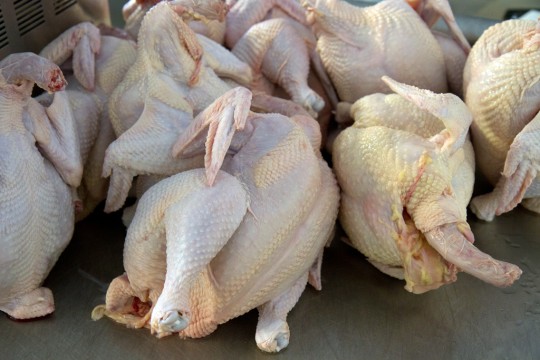The biggest constant in farm life is chores. Every day begins and ends with them, as there are certain tasks that must be done to keep the farm running, and in our case, the animals happy and healthy. For the first 6 weeks or so at North Mountain Pastures, my chores centered around caring for our broilers (that’s what we call the chickens we raise for eating).

It all started with the peeps. 275 of these little newborn chickens arrive on the farm every week or two and they need to be transfered to the brooder – the warm cozy place made of recycled cooler panels and propane heaters where we keep them until they’re big and strong enough to move out to pasture. Perhaps the sweetest task is introducing these guys to their new home and dipping their tiny little beaks in water so they know where to find a drink after that.
Once they’re settled in, they need to be checked in on and fed both morning and night. I’ve had mornings where I’ve chased escaped peeps through mucky corners, cursing their ability to just elude my grasp every time I nearly have them cornered. I’ve also spent mornings tallying a death toll, like when the propane for the heater ran out on a cold night, or when our laying hens were breaking into the brooder to steal feed and bullying the little peeps in the process. But most of the time I find them contentedly chirping and eagerly awaiting breakfast.

After a few weeks, the peeps grow to be little chickens and we transfer them to what we call the chicken tractors – Hoop houses we’ve retrofitted to give the broilers cover from rain and predators, while also giving them plenty of access to run around and eat all the bugs and grass they want. Everyday we use a skid loader (for which I’m still awaiting a driving lesson) to drag the chicken tractors forward one full length to fresh pasture and in exchange they leave behind plenty of precious fertilizer.
The meadow they’re currently circling will eventually be full of rich topsoil and new grass that we can allow the other animals to graze on – in fact, I just noticed yesterday that dark green grass is already springing up where they was only dirt and poop only six weeks ago. These guys also eat loads of feed made locally from organic grain and minerals. Keeping them fed makes for a good workout when you’re hauling buckets and buckets of the stuff.
Are these chickens happy or what? I took this little “bird’s eye view” video one day as the broilers were excitedly tromping around on their new home in the meadow.
Eventually the broilers grow to their full size and it’s time for butchering. This is not a chore but a whole day of processing to ready the birds to be eaten. The night before butchering we head out to the tractors and round up the biggest broilers into crates – chickens are pretty sleepy after dark and there’s a lot less chasing when you catch them at night. The following day we’ll all work together, assembly-line-style, to slaughter, eviscerate, package, weigh and label hundreds of broilers which will eventually make their way into the kitchens of our CSA members.
It’s an intense day, full of blood, guts and feathers, but satisfying when you can see just how much you’ve accomplished at the end. The first time I participated in a butchering day, Brooks trained me to slaughter and I worked my way through 2 crates of laying hens, which are now stewing hens. But generally my place in line has been on the evisceration table where I’ve gotten pretty swift at removing guts and sorting organs. I’ve also been tasked with cutting up chickens for CSA shares, which we do regularly in addition to providing whole broilers for roasting, or better yet, fried chicken.

Another new skill I’ve acquired in this whole broiler operation is the ability to snatch chickens up by their feet and hold 4 or 5 of them in one hand. The first time I saw the guys doing this I thought I’d never have the reflexes to catch those zippy little birds – but when I had to move 250 or so chickens to pasture I got the hang of it pretty quick. But enough of these chickens, I’m now moving on to the pigs.
***
Bonus photo for those who are not faint of heart
If you’re wondering how we do it, here’s Brooks on slaughter and Anna on evisceration.


